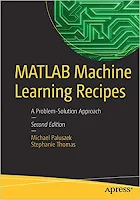Practical Guide for Biomedical Signals Analysis Using Machine Learning Techniques
Abdulhamit Subasi ... 456 pages - Publisher: Academic Press; (March, 2019) ... Language: English - ISBN-10: 0128174447 - ISBN-13: 978-0128174449.
Practical Guide for Biomedical Signals Analysis Using Machine Learning Techniques: A MATLAB Based Approach presents how machine learning and biomedical signal processing methods can be used in biomedical signal analysis. Different machine learning applications in biomedical signal analysis, including those for electrocardiogram, electroencephalogram and electromyogram are described in a practical and comprehensive way, helping readers with limited knowledge. Sections cover biomedical signals and machine learning techniques, biomedical signals, such as electroencephalogram (EEG), electromyogram (EMG) and electrocardiogram (ECG), different signal-processing techniques, signal de-noising, feature extraction and dimension reduction techniques, such as PCA, ICA, KPCA, MSPCA, entropy measures, and other statistical measures, and more. This book is a valuable source for bioinformaticians, medical doctors and other members of the biomedical field who need a cogent resource on the most recent and promising machine learning techniques for biomedical signals analysis.
Practical Guide for Biomedical Signals Analysis Using Machine Learning Techniques: A MATLAB Based Approach presents how machine learning and biomedical signal processing methods can be used in biomedical signal analysis. Different machine learning applications in biomedical signal analysis, including those for electrocardiogram, electroencephalogram and electromyogram are described in a practical and comprehensive way, helping readers with limited knowledge. Sections cover biomedical signals and machine learning techniques, biomedical signals, such as electroencephalogram (EEG), electromyogram (EMG) and electrocardiogram (ECG), different signal-processing techniques, signal de-noising, feature extraction and dimension reduction techniques, such as PCA, ICA, KPCA, MSPCA, entropy measures, and other statistical measures, and more. This book is a valuable source for bioinformaticians, medical doctors and other members of the biomedical field who need a cogent resource on the most recent and promising machine learning techniques for biomedical signals analysis.


